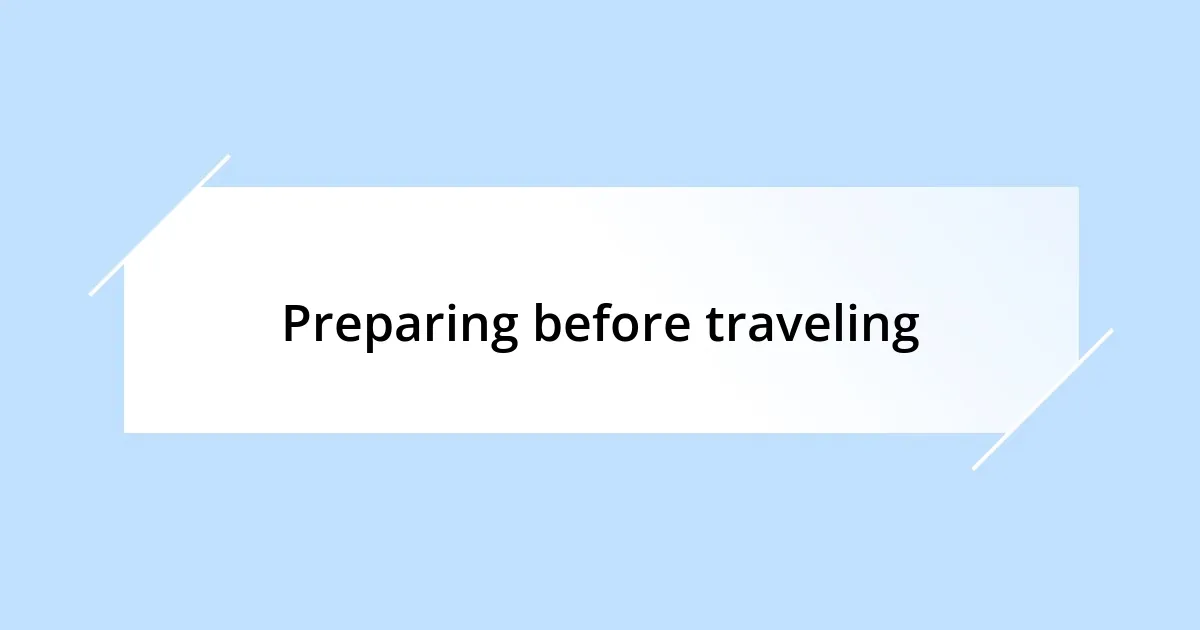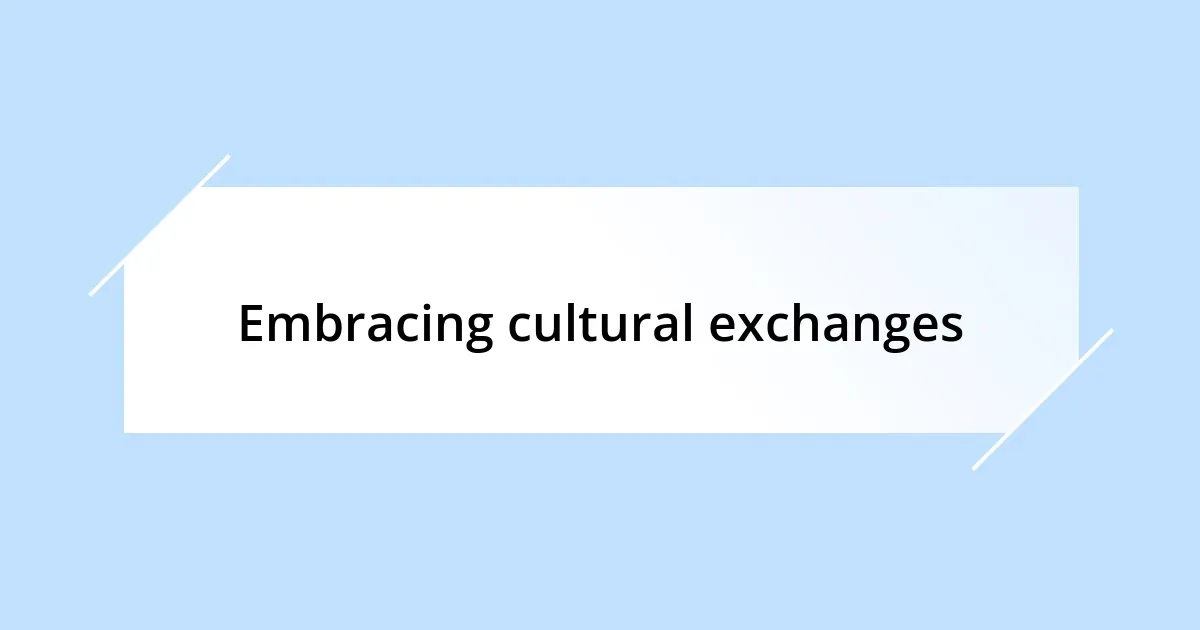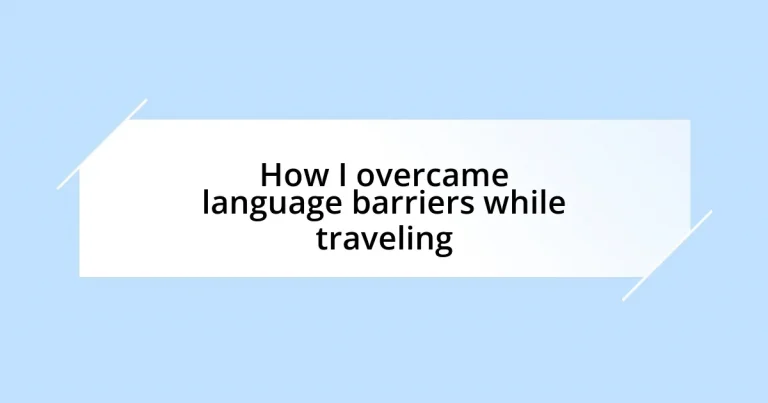Key takeaways:
- Language barriers can hinder communication but can also foster unexpected connections through gestures and effort.
- Preparation, such as learning key phrases and using translation tools, significantly enhances travel experiences and fosters goodwill with locals.
- Effective communication techniques, including active listening and gesturing, can help bridge language gaps and create meaningful interactions.
- Embracing cultural exchanges by engaging in local traditions and sharing meals leads to profound connections and deeper understanding of different cultures.

Understanding language barriers
Language barriers can feel like insurmountable walls when you’re in a foreign country. I remember getting lost in the streets of Rome, trying to ask for directions in my broken Italian. The look of confusion on the local’s face mirrored my own panic, and in that moment, I wondered—how often do we take our ability to communicate for granted?
In my travels, I found that language barriers don’t just inhibit conversations; they can also hinder connections. Once, I met a charming vendor in Mexico who spoke minimal English, and I only knew a handful of Spanish phrases. Yet, we managed to laugh and share stories through gestures and expressions. That connection taught me that sometimes, it’s the effort and intention behind the words that matter more than fluency.
Understanding language barriers is also about recognizing the emotions tied to them. Have you ever felt isolated when surrounded by a different language? I certainly have, and it can be disheartening. Yet, those moments of struggle often prompted me to embrace the experience more wholeheartedly, pushing me to learn new phrases or rely on translations. Each small victory left me with a sense of accomplishment and a deeper appreciation for diverse cultures.

Preparing before traveling
Before traveling, I always take time to prepare myself for potential language obstacles. I remember during my recent trip to Japan, I downloaded a translation app that became my lifeline. It not only helped me order sushi without a hitch, but it also eased the awkwardness I felt when attempting to communicate. Preparing in advance makes a world of difference, doesn’t it?
I find that learning a few essential phrases in the local language can significantly enhance my travel experience. For example, before heading to France, I practiced simple greetings and polite expressions. When I finally chatted with a cafe owner in Paris, the warmth in her eyes when I greeted her in French filled me with joy. It’s amazing how a little effort can break down barriers and foster meaningful interactions.
Moreover, I create a language cheat sheet tailored to my itinerary. This list includes key phrases, common signs, and even cultural nuances. On my adventure in Thailand, having my phrases handy allowed me to navigate the bustling markets confidently. I even left an impression on a vendor by trying to haggle in Thai. It reminded me that preparation is not just about words; it’s about connection and respect for another culture.
| Preparation Method | Benefits |
|---|---|
| Language Apps | Facilitates communication in real-time |
| Learning Key Phrases | Creates goodwill and connection with locals |
| Language Cheat Sheet | Boosts confidence in navigating new places |

Tools for language translation
When it comes to tools for language translation, I’ve learned to appreciate a range of options that can bridge those communication gaps. One of my favorites is Google Translate—it’s versatile and often impressively accurate. I vividly remember standing in a bustling market in Istanbul, armed with my phone, typing out phrases to negotiate prices. The vendor’s eyes grew wide with surprise at my effort, turning what could have been a daunting exchange into a memorable interaction.
Here are some valuable tools that I recommend based on my experiences:
- Translation Apps: Apps like Google Translate or Microsoft Translator can translate text, speech, and even images instantly, making them indispensable while traveling.
- Offline Dictionaries: These come in handy in areas with limited internet access and provide reliable references for common phrases.
- Phrasebooks: A well-rounded phrasebook can serve as a trusty companion, offering not just translations but also insights into cultural nuances and essential etiquette.
- Language Learning Platforms: Resources like Duolingo or Babbel can help you prepare before trips by equipping you with basic vocabulary and phrases, enhancing your interactions with locals.
In many ways, using these tools felt like having an invisible ally by my side. When I ventured to Brazil, my language app not only assisted me in ordering food but also helped me connect with a group of friendly locals. I tested out my beginner Portuguese, and they responded with laughter and encouragement. That moment reminded me that while technology played a significant role, it was my willingness to step outside my comfort zone that truly made the experience enriching.

Techniques for effective communication
When I think about effective communication while traveling, one technique that stands out is gesturing. It’s incredible how a simple thumbs-up or a smile can transcend language barriers. I recall a moment in Colombia when I struggled to explain my need for directions; using enthusiastic gestures, I found myself chuckling with a local who eventually led me to my destination. That shared laughter reminded me that sometimes, body language speaks louder than words.
Active listening is another crucial skill I’ve honed over my travels. When words fail, I focus on the speaker’s tone and facial expressions, which often convey more meaning than you might initially realize. While chatting with a taxi driver in Greece, I noticed his enthusiasm when he spoke about local sights; it encouraged me to ask more questions. It was in those moments of genuine exchange that I truly felt the heartbeat of the culture.
Lastly, I’ve discovered that patience really pays off. Taking a moment to pause and ensure clear understanding can prevent confusion and enhance connection. I remember navigating a restaurant in Mexico where the waiter only spoke Spanish. Instead of rushing the interaction, I took a deep breath, and patiently worked through our conversation. By the end of the meal, we were exchanging stories about our cultures—and honestly, that’s a memory I wouldn’t trade for anything. How have you navigated similar situations?

Embracing cultural exchanges
Embracing cultural exchanges has been one of the most rewarding parts of my travels. I remember attending a local festival in Vietnam, where I was invited to join in a traditional dance. As I stumbled through the steps, laughter erupted around me—not mockingly, but joyfully. In that moment, I felt a wave of acceptance wash over me, reinforcing the idea that stepping into someone else’s shoes can foster incredible connections.
During another trip to Japan, I was invited to share a meal with a fellow traveler and a local family. Despite the language barrier, we communicated through food—each dish sparked questions about its origin and preparation. It was a vibrant tapestry of flavors and stories, where I learned not just about their culinary traditions, but also about their values. Isn’t it amazing how sharing a meal can bridge such profound divides?
I’ve also realized that cultural exchanges often arise in the simplest moments, like chatting with a local artisan while watching them work. I stood mesmerized as a craftsman shaped clay in Morocco, and he taught me a few words in Arabic while sharing the significance of his art. That brief lesson became more than just words; it turned into an understanding of his heritage. If you think about it, what could be more beautiful than learning from one another in these intimate, shared experiences?

Learning key phrases
Learning key phrases can be a game-changer when traveling. I always make it a point to learn essential greetings and polite expressions in the local language. For instance, I was in Portugal and tried saying “obrigado” after receiving help. The gleam in the shopkeeper’s eyes felt like a warm hug. It’s fascinating how a little effort in learning can build bridges, isn’t it?
Moreover, focusing on key phrases relevant to my needs enhances my travel experience immensely. When I found myself in a tiny Parisian café, I used “un café s’il vous plaît” to order my morning pick-me-up. The way the barista smiled and nodded made me feel like I belonged, even if just for a moment. Have you ever noticed how such small interactions can ignite a sense of connection in a foreign place?
I also recommend jotting down these phrases in a dedicated travel notebook. In Italy, I carried mine everywhere, flipping it open to find special phrases like “dove si trova il bagno?” (where is the bathroom?). Not only did it help in practical situations, but it provided conversation starters as locals would often chime in with laughter at my attempts. It’s incredible how a single phrase can spark a delightful dialogue, right?

Building confidence in conversation
Building confidence in conversation often boils down to a willingness to embrace vulnerability. One time, while navigating the bustling streets of Barcelona, I hesitated to ask for directions. I took a deep breath and approached a friendly local. I stumbled over my Spanish, yet the moment I saw her encouraging nod and smile, my nerves faded. It’s remarkable how a simple act of courage can transform a frightening experience into an uplifting interaction, isn’t it?
I’ve found that preparation plays a vital role in boosting my confidence. Before a trip to Brazil, I practiced common phrases with a language app. When I finally had the chance to chat with a group of locals at a beachside bar, my heart raced. Yet, as I shared jokes and laughter, those moments became a blend of language and connection. Reflecting on that experience, I now realize that preparation can ease fear and turn hesitation into engagement. Isn’t it empowering to see how a bit of practice can break down barriers?
Moreover, I’ve discovered that listening actively is just as crucial for building confidence in conversation. One evening in a cozy café in Istanbul, I engaged in a discussion with a young artist. While I may have struggled with some words, I tuned into her stories and emotions. The more I listened, the more I felt emboldened to express my thoughts. It struck me: genuine interest in others not only enriches conversations but also breeds a sense of comfort and camaraderie. Have you ever noticed how the magic of a great conversation often lies in simply being present with someone else?














